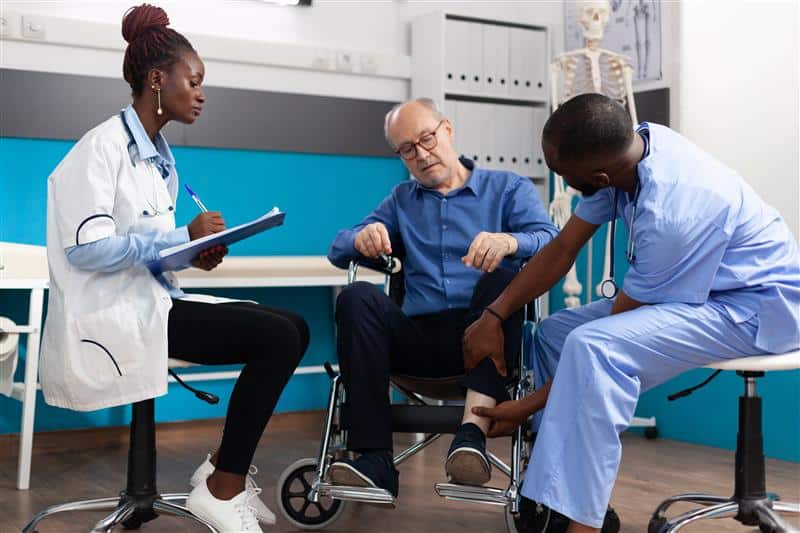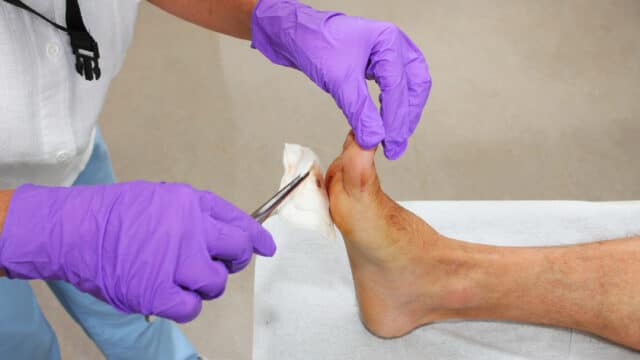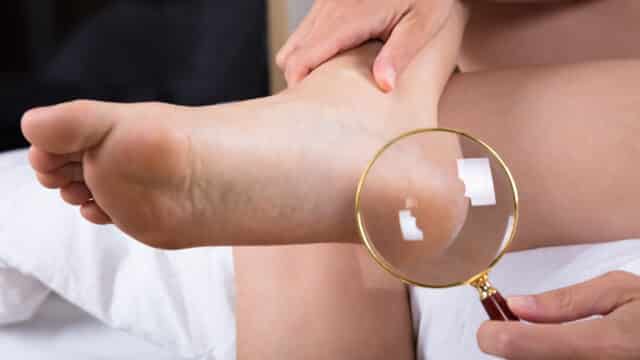Understanding the Stages of Wound Healing: From Inflammation to Remodeling
At Healogics, we understand better than anyone that your body has an amazing ability to repair itself, although the process is complex and can be fragile. We have found that it’s helpful to understand how this process works if you or someone you love has a wound.
The stages of wound healing are a fascinating journey that your body undertakes to restore itself after an injury. Understanding the stages of wound healing in order helps you track your progress and know what to expect. By understanding the healing phases, you can better monitor your wound’s progress and know when to seek professional help if a problem arises.
The Four Stages of Wound Healing
Many of our patients are curious about how their wounds heal. The wound healing process consists of four primary stages that work together to restore your skin’s integrity and function.
Stages of Wound Healing—Quick Guide
- Stage One: Hemostasis: Immediate to several hours
- Stage Two: Inflammation: 1-5 days
- Stage Three: Proliferation: 3-21 days
- Stage Four: Maturation (Remodeling): 21 days to 1 year or more
Let’s explore each of these stages in detail:
Stage One: Hemostasis
Hemostasis begins rapidly after an injury and is the body’s natural process to stop and prevent further bleeding. The term is a combination of two words: hemo, meaning “blood” and stasis, meaning “motionless or stopping.” This process involves three main steps:
- Narrowing of the blood vessels, called vasoconstriction: When you are hurt, the damaged blood vessels quickly narrow themselves. Vasoconstriction helps slow down the blood flow to the injury, reducing blood loss.
- Formation of a platelet plug. Tiny blood cells called platelets rush to the injury site. They stick together (platelet aggregation) and create a temporary seal, like a living band-aid, to cover the tears in the blood vessels.
- Blood clotting: Your body acts quickly to reinforce this platelet plug by creating stringy proteins called fibrin. These act like glue, making the plug stronger and more stable.
All of this happens very rapidly and efficiently. Within seconds of an injury, platelets start gathering at the wound. After about a minute, the fibrin starts to form, and within a few minutes, a full clot is usually in place, signaling the beginning of primary healing.
Stage Two: Inflammatory Response
The inflammatory response usually begins within 24 hours after an injury and lasts between two and five days. We often observe four key signs of inflammation, which are positive indications that your body is actively responding to the injury. The four signs of inflammation are:
- Redness
- Warmth
- Swelling
- Pain
While these symptoms might be uncomfortable, they signal that your body is working hard to protect and heal itself.
The Inflammatory Response: Timeline and Key Players
The inflammatory response in wound healing follows a general timeline: within the first hour after injury, neutrophils arrive at the wound site. They remain the most prevalent cells in the wound for the first two days. From day two to five, macrophages take over as the primary cells, continuing the healing process.
Key Players and Their Roles
Neutrophils
Neutrophils are the most abundant type of white blood cells in the human body and are part of the innate immune system. They are often the first responders to infection or injury. These short-lived calls (surviving from one to five days) are highly mobile and contain granules filled with enzymes and antimicrobial proteins.
In wound healing, neutrophils act as the initial clean-up crew. They remove debris from the wound and fight off bacteria that may have entered. Additionally, they release chemical signals that attract other immune cells, kickstarting the healing process.
Macrophages
Macrophages are large, specialized cells that recognize, engulf, and destroy targeted cells. They are part of both the innate and adaptive immune systems. Made up of monocytes (another type of white blood cell), macrophages are longer-lived than neutrophils and highly adaptable, capable of changing their function based on cues from the environment.
In wound healing, macrophages continue the clean-up work initially begun by neutrophils. They promote new tissue by releasing growth factors and play a vital role in reducing and resolving inflammation. Macrophages also help transition the wound to the next healing stage, bridging the gap between inflammation and tissue repair.
Stage Three: The Proliferation Stage
Proliferation Timeline
The proliferation phase usually begins around day three after an injury and can last for several weeks, depending on the wound size and severity. This stage overlaps with the end of the inflammatory phase and continues until the wound is closed.
Key Processes and Their Roles
Angiogenesis
Angiogenesis is the formation of new blood vessels. During this process, endothelial cells from nearby blood vessels migrate into the wound site and form new capillaries. These new blood vessels are crucial for supplying oxygen and nutrients to the newly forming tissue.
Fibroplasia
Fibroplasia involves the production of collagen and extracellular matrix by fibroblasts. Fibroblasts are cells that synthesize the structural framework for tissues. They migrate into the wound area and begin producing collagen, which provides strength and structure to the new tissue.
Granulation Tissue Formation
Granulation tissue is the new connective tissue and tiny blood vessels that form on the surfaces of a wound during the healing process. It appears as small, red, granular-looking tissue and serves as a scaffold for further tissue repair.
Epithelialization
Epithelialization is the process of covering the wound with new epithelial cells. Epithelial cells from the wound edges and nearby hair follicles migrate across the wound surface, forming a new protective layer. This process effectively closes the wound and restores the skin’s barrier function.
Integrated Healing Process
These processes work in harmony to close the wound and restore skin integrity. As new blood vessels form through angiogenesis, they support the fibroblasts engaged in fibroplasia. The resulting granulation tissue provides a foundation for epithelial cells to migrate across, ultimately sealing the wound. This coordinated effort not only closes the wound but also begins to restore the skin’s structure and function.
Stage Four: Maturation (Remodeling) Stage in Wound Healing
Remodeling Timeline
The maturation or remodeling stage is the final phase of wound healing. It begins around 21 days after the initial injury and can continue for a year or more, depending on the wound’s size and severity.
Key Processes and Their Roles
Collagen Remodeling
During this stage, collagen undergoes significant remodeling. The initial type of collagen deposited in the proliferation phase is gradually replaced by a stronger type of collagen. This process involves the breakdown of old collagen fibers and the synthesis of new ones.
Realignment of Collagen Fibers
Collagen fibers are realigned along tension lines, increasing the tensile strength of the healed tissue. This realignment is crucial for restoring the functional quality of the skin and underlying tissues.
Scar Formation and Maturation
Scar formation is a natural part of the healing process. As the wound continues to heal, the scar undergoes changes:
- Initially, scars may appear red or pink due to the high vascularity and increased blood flow of the newly formed tissue.
- Over time, the scar typically becomes paler and flatter as blood vessels regress and excess collagen is removed.
- The scar tissue gradually becomes more flexible and may shrink in size.
Factors Influencing Scar Formation
Several factors can influence the appearance and quality of the final scar:
- Wound size and depth
- Location on the body
- Individual’s age and overall health
- Genetic factors
- Wound care during earlier healing stages
Long-term Changes
The maturation process can continue long after the wound appears healed:
- Tensile strength of the healed tissue increases over time, potentially reaching up to 80% of the original tissue strength.
- The appearance of scars can continue to improve for months or even years after the initial injury.
- In some cases, abnormal scar formation, such as hypertrophic scars or keloids, may occur, requiring additional medical intervention.
This final stage of wound healing represents the body’s ongoing efforts to restore tissue integrity and functionality, often resulting in a healed wound that closely resembles the surrounding healthy tissue.

How Long Does It Take for a Wound to Heal?
The duration of wound healing varies depending on the type and severity of the wound, as well as individual factors. Here’s a general overview of the healing stages and typical timelines for different wound types.
Typical Healing Times for Different Wound Types
| Wound Type | Approximate Healing Time | |
|---|---|---|
| Minor cuts or scrapes | 3-7 days | |
| Deeper cuts or lacerations | 1-3 weeks | |
| Surgical incisions | 2-4 weeks for initial healing; several months for full strength | |
| Burns (second-degree) | 2-3 weeks | |
| Large or deep wounds | 4-6 weeks or more | |
| Diabetic foot ulcers | Weeks to months |
Factors Influencing Healing Time
Various factors can affect how long it takes for a wound to heal completely:
- Age
- Overall health and nutrition
- Presence of chronic conditions like diabetes or peripheral artery disease (PAD)
- Wound care and hygiene
- Location and depth of the wound
- Blood supply to the affected area
- Stress levels
- Medications
It’s important to note that these timelines are general estimates. Individual healing times can vary significantly based on the factors mentioned above and others. Proper wound care and following medical advice are necessary for optimal healing.
Common Complications in Wound Healing
While the wound healing process is typically efficient, various complications can arise that may impede or alter the normal healing trajectory. Understanding these potential issues is crucial for proper wound management and timely intervention.
Key Complications
Keloids and Hypertrophic Scars
Keloids and hypertrophic scars are both types of abnormal scarring that can occur after skin injury, but they have distinct differences in their causes, appearance, and treatments.
Keloid Scars
- Keloids form due to an overgrowth of granulation tissue (collagen type III) at the site of a healed skin injury.
- Keloid scars expand in claw-like growths over normal skin, extending beyond the original wound boundaries. They can be pink to red or dark brown in color and firm, rubbery, or fibrous in texture.
- Keloids continue to grow over time, even after the initial wound has healed.
- Common locations for keloids include the chest, shoulders, earlobes, and cheeks.
- Keloid scars are more common in people with darker skin tones and those with a family history of keloids.
Hypertrophic Scars
- Hypertrophic scars form from an overproduction of collagen during the wound-healing process.
- They often appear raised and red but remain within the boundaries of the original wound.
- They may continue to thicken for up to 6 months before gradually improving over time.
- Hypertrophic scars can occur anywhere on the body where there’s been an injury or surgery.
Treatment Options
- Pressure therapy
- Silicone gel sheeting
- Corticosteroid injections
- Cryotherapy (freezing)
- Laser therapy
- Surgical excision (though this can sometimes lead to recurrence, especially in keloids)
Impact on Patients
Both types of scars can significantly affect a patient’s physical appearance and comfort:
- Physical discomfort: They can cause itching, pain, or a burning sensation.
- Restricted movement: If these scars are located near joints, they may limit mobility.
- Psychological impact: Hypertrophic and keloid scars can lead to self-consciousness, reduced self-esteem, and in severe cases, social anxiety or depression.
- Functional issues: Depending on location, these scars might interfere with normal bodily functions.
The management of these scars often requires a combination of treatments and ongoing care. It’s important for patients to work closely with dermatologists or plastic surgeons to develop an appropriate treatment plan, as the effectiveness of treatments can vary between individuals.
Infections
Wound infections are a serious complication that can significantly delay healing:
- Common signs include increased redness, swelling, pain, warmth, and purulent or rancid discharge.
- Infections can occur at any stage of wound healing but are most common in the early stages.
- Proper wound care, including cleaning and dressing changes, is crucial in preventing infections.
- If an infection occurs, treatment typically involves antibiotics and possibly debridement of the wound.
Chronic Wounds
Definition
A chronic wound is generally defined as a wound that does not heal in an orderly set of stages and in a predictable amount of time as most wounds do.
Common Types of Chronic Wounds
- Diabetic Ulcers: Often occur on the feet due to nerve damage and poor circulation associated with diabetes.
- Pressure Sores (Bedsores): Develop when prolonged pressure on the skin reduces blood flow to the area, common in bedridden or wheelchair-bound individuals.
- Venous Ulcers: Usually occur on the legs due to poor circulation in the veins.
- Arterial Ulcers: Result from poor blood circulation, often in the lower legs and feet.
Factors Contributing to Chronic Wound Development
Several factors can contribute to the development of chronic wounds:
- Poor circulation
- Diabetes
- Neuropathy (nerve damage)
- Immobility
- Nutritional deficiencies
- Weakened immune system
- Repeated trauma or irritation to the wound area
- Age-related skin changes
Challenges in Treatment and Healing
Chronic wounds present several challenges
- Persistent Inflammation: Chronic wounds often remain in the inflammatory stage, hindering progression to later healing stages.
- Biofilm Formation: Bacteria in chronic wounds can form biofilms, making them resistant to antibiotics and the body’s immune response.
- Reduced Cell Response: Cells in and around chronic wounds may not respond normally to growth factors and other signals that promote healing.
- Underlying Health Issues: The conditions causing the chronic wound (e.g., diabetes) can continue to impede healing efforts.
- Treatment Complexity: Wound management often requires a multidisciplinary approach, addressing both the wound and underlying causes.
- Patient Compliance: Long-term care routines can be challenging for patients to maintain consistently.
- Cost and Resources: Chronic wound care often requires significant time, medical resources, and financial investment.
Understanding these challenges is crucial for developing effective treatment strategies and improving outcomes for individuals with chronic wounds.
How to Speed Up the Healing Process
Promoting faster wound healing involves a multifaceted approach combining proper self-care and medical interventions. A balanced diet rich in protein, vitamins C and A, and zinc, along with adequate hydration, supports tissue repair and immune function. Sufficient rest, stress management, and avoiding smoking and excessive alcohol consumption can also enhance healing. Proper wound care is crucial: keep the wound clean, use appropriate dressings to maintain a moist healing environment, and avoid picking or scratching. Medical interventions can further accelerate healing.
These may include advanced wound dressings, topical treatments like antibiotic ointments or growth factor gels, debridement to remove dead tissue, hyperbaric oxygen therapy to increase oxygen supply, and negative pressure wound therapy to manage excess fluid. Always follow your healthcare provider’s instructions and monitor for signs of infection. While these strategies can help, healing takes time, and the effectiveness may vary depending on the wound type, severity, and individual factors. Consistent care and patience are key to optimal wound healing.
To find a Healogics Wound Care Center near you or to schedule an appointment, click here or visit our website at https://www.healogics.com/. No referral is needed to receive the specialized care your wound deserves.


